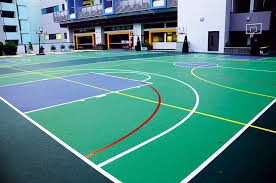Why Sports Flooring Matters: Benefits, Types & Installation Tips

Strong 8k brings an ultra-HD IPTV experience to your living room and your pocket.
When it comes to building a quality sports facility, most people focus on lighting, equipment, or ventilation. But there's one element that often gets overlooked and yet impacts performance more than anything else—sports flooring. Unlike standard flooring used in homes or offices, sports flooring is engineered specifically for safety, durability, and performance. Whether you're setting up a basketball court, a gym, or a multi-sport complex, the type of floor you install can make or break the experience for athletes and users alike.
Key Benefits of Sports Flooring
1. Performance Enhancement:
The right sports flooring can significantly boost an athlete’s performance. Whether it's a cushioned surface that helps in jump-heavy sports like volleyball, or a non-slip layer that allows for sharp movements in basketball, specialized flooring gives athletes the edge. A well-constructed floor provides proper bounce, grip, and comfort—elements that can’t be achieved with standard flooring materials like bathroom tile or ceramic. Chemcore Construction Pvt Ltd specializes in designing and installing high-performance sports flooring solutions tailored to meet the unique demands of each sport.
2. Injury Prevention:
Sports flooring reduces the risk of injury by absorbing impact and reducing stress on joints and muscles. This is especially important in high-impact sports like basketball, wrestling, and gymnastics. Slippery, hard floors increase the chances of falls and long-term injuries, making proper flooring a must for athlete safety.
3. Durability:
Unlike home flooring, sports surfaces face tremendous wear and tear. With thousands of footfalls, dropped equipment, and spills, only high-durability flooring like rubber, vinyl, or epoxy can survive the long haul. These materials resist damage, fading, and cracking, making them ideal for high-traffic areas.
4. Easy Maintenance:
Materials like epoxy and vinyl are not only durable but also easy to clean. Most sports flooring options are water-resistant and can be maintained with regular sweeping and occasional mopping—keeping the space hygienic and safe.
Popular Types of Sports Flooring
1. Wooden Flooring:
Typically seen in basketball courts, maple wood provides a consistent bounce and smooth surface. It’s aesthetically pleasing and ideal for indoor use but can be costly and requires regular maintenance to stay in top condition.
2. Rubber Flooring:
Perfect for gyms and fitness areas, rubber flooring offers excellent shock absorption and traction. It's durable, slip-resistant, and works well in both indoor and outdoor settings. It’s also eco-friendly, often made from recycled materials.
3. Vinyl Flooring:
Vinyl is a budget-friendly option that’s great for multipurpose sports halls. It comes in various patterns and thickness levels, offering moderate cushioning and easy installation. It’s also resistant to moisture and stains.
4. Epoxy Flooring:
Best for weight rooms and high-performance gyms, epoxy flooring is known for its durability and glossy finish. While it doesn’t offer much cushioning, it excels in load-bearing and is resistant to chemicals and abrasions.
5. Polyurethane (PU) Flooring:
PU floors are seamless, hygienic, and highly customizable. They’re perfect for indoor sports where safety and shock absorption are priorities. Plus, they’re easy to maintain and look great for years.
Factors to Consider Before Installation
Before choosing your sports flooring, consider the type of sport being played, the frequency of use, and the environmental conditions. If you're installing flooring outdoors, make sure it’s UV and weather-resistant. For indoor spaces with heavy foot traffic or equipment use, durability and shock resistance should be top priorities.
Also, think about long-term costs. While vinyl might be cheaper initially, rubber or polyurethane could be more cost-effective in the long run due to their durability and low maintenance needs.
Installation Tips
Installing sports flooring isn’t a typical DIY job. It involves precision, surface preparation, and often, the use of construction chemicals to ensure adhesion and performance. These chemicals play a role in leveling the subfloor, enhancing moisture resistance, and improving durability.
Pro tips for installation:
Always prep the base floor properly to avoid cracks or bubbles later.
Use high-quality adhesives and sealants for long-lasting results.
Allow proper curing time before use to ensure the surface settles completely.
Hiring professionals familiar with sports flooring and using the right materials is key to a successful installation.
Conclusion
Your sports flooring isn’t just a base—it’s a performance tool, a safety layer, and a long-term investment. Whether you're building a professional court, a school gym, or a home training zone, choosing the right flooring can significantly enhance user experience and reduce injuries. From wood to rubber to epoxy, each material offers unique benefits. Match your flooring to your sport, your budget, and your maintenance capability—and you'll create a space that performs as hard as the athletes on it.
FAQs
1. What’s the best sports flooring for gyms?
Rubber flooring is the best choice for gyms due to its shock absorption, durability, and slip resistance.
2. How long does sports flooring last?
With proper maintenance, high-quality sports flooring can last 10–20 years.
3. Can I install sports flooring myself?
It’s recommended to hire professionals, especially when using construction chemicals or installing epoxy or polyurethane surfaces.
4. Is epoxy flooring good for sports?
Yes, especially for gyms and weight rooms. It’s durable and easy to clean but not ideal for high-impact sports.
5. Why are construction chemicals important in sports flooring?
They enhance adhesion, durability, and moisture resistance—ensuring the floor performs well under stress.
Note: IndiBlogHub features both user-submitted and editorial content. We do not verify third-party contributions. Read our Disclaimer and Privacy Policyfor details.


